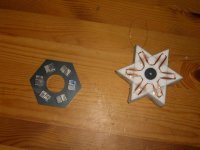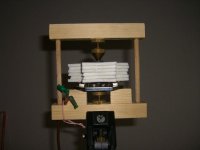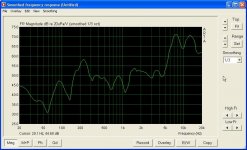otherwise we're just wasting or even amusing the forum members
Carry on lads 🙂
But seriously. I think there should be effort made regarding disambiguation of the principle of operation for PlanoT. After all, it's R&D such as this that often turns up new possibilities.
Cheers,
Ed
Agreed 100% Ed.
But that's what really gets me up on my hind quarters - the fact that they refuse to provide us with the basic information we require and protect this ''ambiguous'' product with everything they've got .
There is no place for this type of mentality on this forum - we are here to share our findings, not hide them, cause arguments and create tension amongst members.
As far as I'm concerned, it's a SIMPLE device,producing sound by a simple method(already invented or discovered ages ago) not the world's greatest invention since sliced bread!
Prove to me and the others that have tried this system that we are FAR SHORT from the real operating method involved.
I can only assume at this stage(from my own and other people's experiments) that the rotation of the diaphragm is a result of the movement of the voice coil in it's bearing.😉. IMHO, It's not a ''positive or negative pressure wave chopper'' Anything attached to a voice coil, be it vertical or horizontal in it's movement, with either a cone,rod, cardboard, foam or whatever attached, WILL PRODUCE SOUND .......no secret about that?
No one is disputing that the shape and size of the diaphragm is important to the overall projection of sound waves and frequency response, but c'mon! give us more than that or go away and leave us alone.
We'll all wait for a review in Stereophile, Hi-Fi +, Hi-Fi World magazine etc.
Maybe then some'' brainiac'' can finally disclose the mysterious operating principle and how good or bad it sounds🙄
But that's what really gets me up on my hind quarters - the fact that they refuse to provide us with the basic information we require and protect this ''ambiguous'' product with everything they've got .
There is no place for this type of mentality on this forum - we are here to share our findings, not hide them, cause arguments and create tension amongst members.
As far as I'm concerned, it's a SIMPLE device,producing sound by a simple method(already invented or discovered ages ago) not the world's greatest invention since sliced bread!
Prove to me and the others that have tried this system that we are FAR SHORT from the real operating method involved.
I can only assume at this stage(from my own and other people's experiments) that the rotation of the diaphragm is a result of the movement of the voice coil in it's bearing.😉. IMHO, It's not a ''positive or negative pressure wave chopper'' Anything attached to a voice coil, be it vertical or horizontal in it's movement, with either a cone,rod, cardboard, foam or whatever attached, WILL PRODUCE SOUND .......no secret about that?
No one is disputing that the shape and size of the diaphragm is important to the overall projection of sound waves and frequency response, but c'mon! give us more than that or go away and leave us alone.
We'll all wait for a review in Stereophile, Hi-Fi +, Hi-Fi World magazine etc.
Maybe then some'' brainiac'' can finally disclose the mysterious operating principle and how good or bad it sounds🙄
I only live 2 hours away from Omaha. I'd love to go listen to one of the prototypes, just out of curiosity! I wonder if he would be down with giving a demo? 🙂
Ziggy, I'm with you on all of this, and my suggestion for mechanism disambiguation is more aimed at the inventor than anyone else...
Of course, it is the perogative of the inventor to present as much or as little as they wish. We just have to take things at face value, and hope that more will come eventually.
Cheers,
Ed
Of course, it is the perogative of the inventor to present as much or as little as they wish. We just have to take things at face value, and hope that more will come eventually.
Cheers,
Ed
Yes, Ed. I'm leaving this where it is - nowhere.
I am almost certain that I have hit a nerve amidst all the secrecy and non disclosure.
I really don't care somehow......I have my hands full with my own hand built, fully functional giant NXT panels and I'm delighted with them !.............and guess what?...........they don't have to spin or rotate to work!!😀
I am almost certain that I have hit a nerve amidst all the secrecy and non disclosure.
I really don't care somehow......I have my hands full with my own hand built, fully functional giant NXT panels and I'm delighted with them !.............and guess what?...........they don't have to spin or rotate to work!!😀
related to THIS?
Is the PlanOT related to this patent application?
http://appft1.uspto.gov/netacgi/nph-Parser?Sect1=PTO2&Sect2=HITOFF&u=%2Fnetahtml%2FPTO%2Fsearch-adv.html&r=1&p=1&f=G&l=50&d=PG01&S1=%28%28Diaphragm.TTL.+AND+boxless.TTL.%29+AND+rotary.TTL.%29&OS=ttl/Diaphragm+and+ttl/boxless+and+ttl/rotary&RS=((TTL/Diaphragm+AND+TTL/boxless)+AND+TTL/rotary)
Is the PlanOT related to this patent application?
http://appft1.uspto.gov/netacgi/nph-Parser?Sect1=PTO2&Sect2=HITOFF&u=%2Fnetahtml%2FPTO%2Fsearch-adv.html&r=1&p=1&f=G&l=50&d=PG01&S1=%28%28Diaphragm.TTL.+AND+boxless.TTL.%29+AND+rotary.TTL.%29&OS=ttl/Diaphragm+and+ttl/boxless+and+ttl/rotary&RS=((TTL/Diaphragm+AND+TTL/boxless)+AND+TTL/rotary)
D'oh!
I see you are right there. I haven't been following this post for a few months, but I came across that patent application accidentally and thought "Hey! That's gotta be the Planot thing"
Now that I have caught up on this thread, I still don't see this driver type as viable.
It does seem to have yielded some interesting discussion, and a few people have apparently even built a few prototypes.
My big question is still this: Even under perfect conditions, does this design make any sense?
My understanding is that the invention is basically a rotating prism surface acting as a line source. This element is to be driven like the center of a clothes washing machine, right?
Even if we have some infinitely rigid magic balsa wood, and unlimited amplifier power, isn't this still just a driver that pumps the back wave out right next to the front wave? How can it be considered an omnidirectional radiator when if will be effectively be shooting out cancellation silence perpendicular to each face?
It appear that the only audible sounds made will be coming from the various distortion components.
When I first started reading this thread, I really WANTED it to work, and assumed I was missing something in how it was supposed to work. After re-reading it all, I am really getting the impression that it will not work, by design.
I feel like I am reading a patent on a perpetual motion machine. It just seems to be flawed science.
Can anyone here help me in the slightest bit to see how this device could possibly make any useful sound?
SY said:Yes, that's the application I mentioned a few posts back.
I see you are right there. I haven't been following this post for a few months, but I came across that patent application accidentally and thought "Hey! That's gotta be the Planot thing"
Now that I have caught up on this thread, I still don't see this driver type as viable.
It does seem to have yielded some interesting discussion, and a few people have apparently even built a few prototypes.
My big question is still this: Even under perfect conditions, does this design make any sense?
My understanding is that the invention is basically a rotating prism surface acting as a line source. This element is to be driven like the center of a clothes washing machine, right?
Even if we have some infinitely rigid magic balsa wood, and unlimited amplifier power, isn't this still just a driver that pumps the back wave out right next to the front wave? How can it be considered an omnidirectional radiator when if will be effectively be shooting out cancellation silence perpendicular to each face?
It appear that the only audible sounds made will be coming from the various distortion components.
When I first started reading this thread, I really WANTED it to work, and assumed I was missing something in how it was supposed to work. After re-reading it all, I am really getting the impression that it will not work, by design.
I feel like I am reading a patent on a perpetual motion machine. It just seems to be flawed science.
Can anyone here help me in the slightest bit to see how this device could possibly make any useful sound?
Can anyone here help me in the slightest bit to see how this device could possibly make any useful sound?
Distributed vibrational modes. I recommend you read Ziggy's thread on "NXT...." elsewhere in this section. Even if the initial impulses are torsional, flexure and boundary reflections in the triangular beam will ensure that the waves created are redistributed in a complex fashion throughout this element of the structure.
Ed
Ed, thanks. At least now I can see that it's at least POSSIBLE.
My experience with NXT exciters and variants leads me to believe that it's still not very LIKELY to work as described.
Don't get me wrong -- I would love for it to work.
My "thought experiments" are going a bit like this:
--stick an exciter on one end of a long skinny strip of material (balsa, Gatorboard, etc.) and I have just made a worst.-case panel (skinny, only one exciter, driven not from the center...) I seriously would not expect to hear anything coming out of it below about 1kHz...
--stick an exciter on a rigid 3 dimensional object (like a prism) and get NO distributed mode activity. My understanding is that the effect relies heavily on the nearly 2 dimensional nature of the excited object
Please, someone tell me they have made one and are getting anything more than sound from the table that is it sitting on.
Again, really not trying to poo-poo the idea at all. it's just that I need to see HOW it can work, OR see THAT it does work.
Until that time, it just sits in my head labeled as "paranormal" audio technology.
My experience with NXT exciters and variants leads me to believe that it's still not very LIKELY to work as described.
Don't get me wrong -- I would love for it to work.
My "thought experiments" are going a bit like this:
--stick an exciter on one end of a long skinny strip of material (balsa, Gatorboard, etc.) and I have just made a worst.-case panel (skinny, only one exciter, driven not from the center...) I seriously would not expect to hear anything coming out of it below about 1kHz...
--stick an exciter on a rigid 3 dimensional object (like a prism) and get NO distributed mode activity. My understanding is that the effect relies heavily on the nearly 2 dimensional nature of the excited object
Please, someone tell me they have made one and are getting anything more than sound from the table that is it sitting on.
Again, really not trying to poo-poo the idea at all. it's just that I need to see HOW it can work, OR see THAT it does work.
Until that time, it just sits in my head labeled as "paranormal" audio technology.
Oh God............here we go again 
Needed(sorry for the abbreviation), oh yes........you'll get sound coming from the ''triangle''.........but it's not a lot, and as you say, not much below 1khz.
However, the better the construction, the tighter the tolerances etc..........the more sound that the triangular diaphragm will produce. But!!!........place it on a resonant table top and guess what happens??

Needed(sorry for the abbreviation), oh yes........you'll get sound coming from the ''triangle''.........but it's not a lot, and as you say, not much below 1khz.
However, the better the construction, the tighter the tolerances etc..........the more sound that the triangular diaphragm will produce. But!!!........place it on a resonant table top and guess what happens??

I find the interpretation a bit tricky. Is the break in the frequency response around 5kHz a result of the acoustic short circuit (which would be the proof that the Planot-principle doesn´t work) or is it the breakup frequency above which there are running waves through the Rohacell star?
Measuring from different locations while playing a continuous tone could show you if the dip is resulting from a cancellation in-air after leaving the driver.
Playing a sweep on a nearby loudspeaker and then measuring the current induced on the coil (basically using the driver as a microphone) may reveal some resonances of the driver itself.
Looking at your implementation, I have a few questions:
What is the total mass of your coil?
What is the total mass of your magnets?
It almost appears that they may be of comparable magnitude, but I am seeing only one surface of the magnets.
Playing a sweep on a nearby loudspeaker and then measuring the current induced on the coil (basically using the driver as a microphone) may reveal some resonances of the driver itself.
Looking at your implementation, I have a few questions:
What is the total mass of your coil?
What is the total mass of your magnets?
It almost appears that they may be of comparable magnitude, but I am seeing only one surface of the magnets.
el`Ol said:I find the interpretation a bit tricky. Is the break in the frequency response around 5kHz a result of the acoustic short circuit (which would be the proof that the Planot-principle doesn´t work) or is it the breakup frequency above which there are running waves through the Rohacell star?
I don't think you can disprove the "Planot principle" based on your results with a shape other than that outlined by its inventor.
Do we actually have a well-defined "planot principle" here?
Do we think it involves distributed mode radiation necessarily?
Do we think it involves distributed mode radiation necessarily?
neededandwanted said:Measuring from different locations while playing a continuous tone could show you if the dip is resulting from a cancellation in-air after leaving the driver.
Playing a sweep on a nearby loudspeaker and then measuring the current induced on the coil (basically using the driver as a microphone) may reveal some resonances of the driver itself.
Looking at your implementation, I have a few questions:
What is the total mass of your coil?
What is the total mass of your magnets?
It almost appears that they may be of comparable magnitude, but I am seeing only one surface of the magnets.
I measured from different positions and there wasn´t much difference. The mass of the star is 10g, the mass of the coil is near to nothing and the magnets are 5mm thick and rest on 5mm thick iron.
- Status
- Not open for further replies.
- Home
- Loudspeakers
- Planars & Exotics
- Triangle shaped metal music maker?



